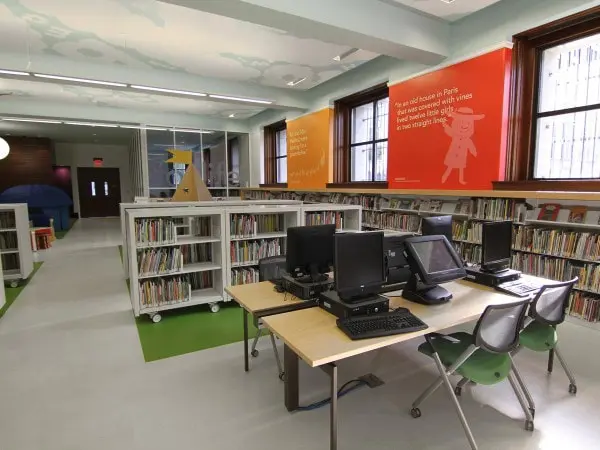
Introduction
Libraries have long been an essential part of our communities, providing us with access to knowledge and resources. However, as libraries continue to serve a growing population, the need for efficient storage solutions becomes more pronounced. Innovative storage solutions offer libraries the ability to optimize space, enhance organizational efficiency, and provide flexibility for future growth. In this blog, we will explore the evolution of library storage systems, the demand for efficient space management, key features of innovative library storage solutions, their impact on different sectors, practical tips for implementation, and the role of Bradford Systems in revolutionizing library storage. Let’s dive in and discover the exciting world of innovative storage solutions for libraries.
The Evolution of Library Storage Systems
Library storage solutions are not limited to mere bookshelves or physical storage spaces. They encompass a range of innovative approaches that focus on space optimization, strategic planning, and organizational efficiency. As libraries strive to meet the evolving needs of their users, traditional storage methods often fall short in maximizing space usage and providing efficient access to library resources. Innovative storage solutions, such as virtual libraries and digital archives, address these challenges by revolutionizing library storage methodology, enhancing space optimization, and streamlining library operations. Understanding the need for these innovative solutions is crucial in creating efficient and effective physical spaces for libraries.
Over the years, library storage systems have evolved to adapt to the changing needs of libraries and their users. Traditional library shelving, while functional, often fails to maximize space usage, resulting in cluttered, disorganized storage areas. Innovative storage solutions, such as high-density shelving, have transformed library storage by providing compact, space-saving options. Customizable storage solutions, including wire shelving, have also reshaped library storage systems, allowing libraries to tailor their storage solutions to their unique needs. By embracing innovative storage solutions, libraries can enhance organizational efficiency, optimize space, and improve access to resources.
Efficient space management is crucial for library storage solutions, especially as real estate becomes increasingly scarce and expensive. Libraries must make the most of their available square footage to accommodate growing collections, diverse materials, and evolving user needs. Innovative storage solutions focus on space optimization, offering high-density shelving options that maximize storage capacity without compromising accessibility. By making efficient use of space, libraries can create a clutter-free environment, improve workflow, and ensure that resources are easily accessible to users for new purposes. With innovative storage solutions, libraries can optimize their space, make the most of their real estate, and provide an enhanced user experience.
Key Features of Innovative Library Storage Solutions
Innovative library storage solutions offer a range of key features that contribute to space optimization, organizational efficiency, and improved access to resources. High-density shelving, for example, allows libraries to maximize space usage by compacting shelving units and creating aisles that can be opened or closed as needed. Customizable storage solutions provide libraries with the flexibility to tailor storage systems to their unique needs, ensuring efficient utilization of space and enhancing the interior design of the space. By embracing innovative storage solutions, libraries can enhance organizational efficiency, streamline operations, and provide an improved user experience for their patrons.
High-density shelving is a key feature of innovative library storage solutions, allowing libraries to make the most of their space while maintaining accessibility to resources. Here are some key advantages and benefits of high-density shelving:
- Space optimization: High-density shelving enables libraries to maximize storage capacity by compacting shelves and utilizing vertical space, resulting in significant space savings.
- Improved organization: High-density shelving allows for better organization and categorization of resources, making it easier for users to locate items quickly.
- Customizable floor plans: High-density shelving can be customized to fit unique floor plans, creating a storage system that seamlessly integrates with the library’s layout.
- Enhanced accessibility: High-density shelving ensures that resources remain easily accessible, with shelving units that can be moved and opened as needed.
- Increased storage capacity: High-density shelving systems can significantly increase storage capacity, allowing libraries to accommodate growing collections without expanding their physical footprint.
Customizable Storage Solutions: Tailoring Systems to Unique Library Needs
Here are some key advantages and benefits of customizable storage solutions:
- Planning process: Customizable storage solutions involve a planning process that takes into account the library’s specific needs, resources, and space constraints.
- Unique needs: Customizable storage solutions can be designed to accommodate a wide range of materials, from books and archives to multimedia resources, ensuring that all library resources are stored in an organized and accessible manner.
- Efficient space utilization: Customizable storage solutions optimize space usage by adapting storage systems to fit the available space, making the most of every square foot.
- Flexibility and scalability: Customizable storage solutions can be easily modified or expanded to accommodate future growth, allowing libraries to adapt as their collections and storage needs change.
- Improved workflow: Customizable storage solutions promote efficient workflows by ensuring that resources are stored in a logical, organized manner, making it easier for library staff to locate and retrieve items for users.
Organizational efficiency is a crucial aspect of library operations, and innovative storage solutions play a vital role in streamlining workflows and improving efficiency. Here are some ways in which advanced storage solutions contribute to organizational efficiency:
- Workflow optimization: Advanced storage solutions, such as high-density shelving and customizable storage systems, enhance workflow efficiency by improving the organization, accessibility, and retrieval of resources.
- Space optimization: By maximizing storage capacity and making efficient use of space, innovative storage solutions create a clutter-free environment that promotes efficiency and productivity.
- Enhanced inventory management: Innovative storage solutions provide libraries with better control over their collections, allowing for accurate tracking, easy inventory management, and efficient resource allocation.
- Improved user experience: By optimizing storage and accessibility, innovative storage solutions ensure that resources are readily available to users, resulting in a streamlined, user-friendly experience and improved satisfaction.
- Time savings: Efficient storage solutions minimize the amount of time spent searching for resources, allowing library staff to focus on other important tasks, such as customer service and program development.
Bradford Systems’ Approach to Library Storage Solutions
Bradford Systems takes a comprehensive approach to library storage solutions, combining years of experience with a strategic methodology that ensures successful implementation. Here’s an overview of Bradford Systems’ approach:
- Methodology: Bradford Systems follows a proven methodology that includes a thorough assessment of the library’s current storage system, engaging with end users, decision makers, and facility managers, and planning for long-term efficiency.
- Customizable solutions: Bradford Systems believes in tailoring storage solutions to meet the specific needs of each library, taking into account unique constraints, circulation numbers, and space usage patterns.
- Case studies: Bradford Systems showcases its expertise through case studies, highlighting successful projects and demonstrating the positive impact of innovative library storage solutions on different libraries and sectors.
The Impact of Innovative Library Storage Solutions on Different Sectors
Innovative library storage solutions have a profound impact on various sectors, including healthcare, education, and athletics. By maximizing space, improving efficiency, and enhancing storage capabilities, innovative storage solutions cater to the unique needs of these sectors, contributing to improved patient care, an enhanced learning environment, and efficient storage of athletic equipment. Let’s explore the impact of innovative library storage solutions on these diverse industries and how they contribute to their specific storage needs.
Healthcare Storage Solutions: Maximizing Space and Efficiency in Medical Libraries
Innovative storage solutions play a crucial role in medical libraries, where space optimization and efficiency are paramount for patient care and healthcare professionals. Here are some ways in which healthcare storage solutions impact medical libraries:
- Maximizing space: Innovative storage solutions enable medical libraries to maximize storage capacity, ensuring the efficient storage of important resources.
- Improved patient care: Organized storage systems allow healthcare professionals to quickly access medical literature and resources, leading to efficient decision-making and improved patient care.
- Enhanced efficiency: Innovative storage solutions eliminate clutter, optimize workflows, and enhance efficiency, reducing the time spent searching for resources and improving overall productivity.
Education Storage Solutions: Enhancing Learning Environments with Optimized Library Storage
Innovative storage solutions have a significant impact on school libraries, contributing to enhanced learning environments and efficient storage of educational resources. Here’s how education storage solutions benefit school libraries:
- Optimized storage: Innovative storage solutions ensure that school libraries can effectively organize and store a diverse range of educational resources, such as books, multimedia, and supplies.
- Enriched learning environment: Customizable storage solutions create an aesthetically pleasing environment that promotes student engagement, creativity, and collaboration.
- Efficient circulation: By optimizing storage, innovative solutions allow school libraries to efficiently manage circulation, making resources more accessible for students and educators.
- Space optimization: Education storage solutions make the most of available space in school libraries, creating room for additional resources, flexible learning areas, or expanded programming.
Athletic Equipment Storage: Efficient Use of Library Space in Sports Facilities
Efficient storage of athletic equipment is crucial in sports facilities, and innovative storage solutions provide the means to optimize library space for this purpose. Here’s how innovative library storage solutions impact sports facilities:
- Space optimization: Innovative storage solutions for athletic equipment maximize space usage, ensuring that sports facilities can store equipment efficiently without sacrificing valuable floor space.
- Organizational efficiency: Athletic equipment storage solutions streamline operations, making it easier for staff to access and manage equipment, resulting in improved efficiency and reduced downtime.
- Enhancing access: With innovative storage solutions, athletic equipment can be stored in a secure, organized manner, ensuring that it is readily available when needed, enabling smooth facilitation of sporting activities and events.
- Flexibility for multi-purpose spaces: Innovative storage solutions create flexible spaces, allowing sports facilities to easily transition between different activities or events, depending on their needs.
Practical Tips for Implementing Innovative Library Storage Solutions
Implementing innovative library storage solutions requires careful planning and consideration. Before implementing innovative storage solutions, it is important to assess the library’s current storage system to identify opportunities for improvement and determine the best approach for optimization. Key considerations include:
- Assessment process: Conduct a comprehensive assessment of the current storage system, taking into account storage space, square footage, usage patterns, and retention needs.
- Engaging stakeholders: Involve end users, decision makers, facility managers, and other stakeholders in the assessment process to gather valuable insights and ensure the implementation aligns with strategic planning.
- Identifying challenges: Identify any challenges or limitations of the current storage system, such as inefficient use of space, accessibility issues, or outdated technology.
Optimizing library storage requires expertise and experience. Engaging professional help can ensure the successful implementation of innovative storage solutions. Consider the following:
- Utilize professional services: Seek assistance from storage solution providers or consultants who specialize in library storage optimization, ensuring access to industry expertise and best practices.
- Collaborate with stakeholders: Work closely with professionals, facility managers, decision makers, and end users to ensure storage solutions align with organizational goals, resources, and long-term plans.
- Customized approach: Engage with professionals who can offer customized solutions tailored to the library’s unique storage needs, square footage, and organizational structure.
Optimizing storage efficiency requires ongoing maintenance and periodic upgrades. Consider the following practices:
- Maintain storage systems: Implement regular maintenance plans to ensure that storage solutions remain in optimal condition, perform efficiently, and meet safety standards.
- Plan for upgrades: Periodically assess storage systems to identify opportunities for upgrades, such as incorporating new technology, expanding storage capacity, or improving functionality.
- Long-term efficiency: Consider the long-term benefits of regular maintenance and strategic upgrades, as they contribute to extended efficiency, cost savings, and a seamless user experience.
Implementing innovative library storage solutions comes with its challenges, but strategic planning and solutions-oriented approaches can help overcome obstacles. Here are some common challenges and solutions:
- Budget limitations: Identify cost-effective solutions that align with budget constraints, leverage grant opportunities, or consider phased implementations.
- Space constraints: Optimize storage space by exploring high-density shelving, compact shelving, or mobile shelving solutions that maximize storage capacity within existing square footage.
- Accessible shelving: Address accessibility concerns, such as accommodating patrons with physical disabilities, by implementing adjustable shelving units, incorporating ramped access, or considering the layout of shelving solutions.
- Staff training: Invest in staff training to ensure library personnel are well-versed with operating storage solutions, maintaining equipment, and optimizing storage space.
Budget limitations are a common challenge when implementing innovative storage solutions, but cost-effective options can still be explored. Consider the following strategies:
- Research available options: Conduct thorough research to find storage solutions that offer the best value for the library’s budget, always keeping storage efficiency and long-term benefits in mind.
- Explore grant opportunities: Investigate potential grants or funding sources to help offset the initial investment of innovative storage solutions.
- Phased implementation: Implement storage solutions in phases, starting with critical areas or high-priority storage needs and gradually expanding as budget allows.
- Collaborate with vendors: Engage with storage solution vendors to explore cost-effective options, negotiate pricing, and consider leasing or financing arrangements to spread out costs over time.
Frequently Asked Questions
Innovative library storage solutions have the potential to contribute to sustainable practices, promoting environmental responsibility and reducing the library’s carbon footprint. Consider the following ways in which innovative storage solutions support sustainability:
- Space optimization: By maximizing storage capacity, innovative storage solutions minimize the need for additional floor space, reducing the environmental impact of new construction or expansion.
- Clutter reduction: Innovative storage solutions focus on decluttering library storage spaces, promoting a more organized environment, and reducing waste by eliminating excess shelving units or storage equipment.
- Efficient resource usage: With improved workflow efficiency and access to resources, innovative storage solutions reduce the time, energy, and resources required to retrieve items, resulting in less waste and enhanced sustainability.
- Long-term durability: Innovative storage solutions are designed to be durable and long-lasting, minimizing the need for frequent replacements or repairs, and reducing the environmental impact of storage equipment.
Libraries can explore a range of unique storage solutions to maximize space and efficiency. Here are some examples:
- Mobile shelving: Mobile shelving units can be easily moved, creating more open space when needed and maximizing storage capacity.
- Compact shelving systems: Compact shelving systems minimize the amount of floor space used, allowing libraries to store more books in a smaller area.
- Automated storage and retrieval systems (ASRS): ASRS utilize technology to store items in a smaller footprint, providing quick access to materials and reducing the need for staff labor.
- Customized bookcases with adjustable shelves: Custom bookcases can accommodate different book sizes, optimizing storage space, and providing a unique visual appeal.
Innovative storage solutions can help libraries maximize space by utilizing vertical space, compacting storage units, and optimizing shelving design. Here are some ways these solutions contribute to space optimization:
- High-density shelving: High-density shelving allows libraries to make the most of their vertical space, creating space-saving storage units.
- Mobile shelving: Mobile shelving units can be moved to create more open space whenever needed, allowing libraries to adapt storage configurations to their specific needs.
- Compact shelving systems: Compact shelving systems reduce the footprint of traditional shelving, freeing up floor space for additional resources or flexible usage.
- Automated storage and retrieval systems: ASRS store materials in a smaller footprint, optimizing space usage while providing quick, automated access to resources.
Innovative storage solutions cater to a wide range of materials and books, including rare and fragile items. Consider these factors when selecting storage options:
- Material compatibility: Different storage options can be tailored to suit specific materials, such as temperature-controlled environments for sensitive materials or acid-free storage solutions for rare books.
- Specialized storage: Innovative solutions offer special compartments or features to accommodate unique storage requirements, such as media storage, archival storage, or artwork display.
- Size considerations: Customizable storage solutions allow for adjustable shelves, ensuring resources of different sizes can be stored efficiently, preventing wasted space and promoting better organization.



